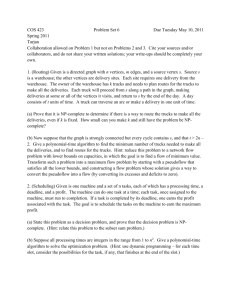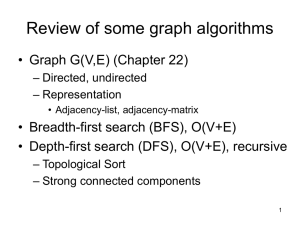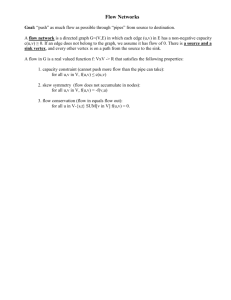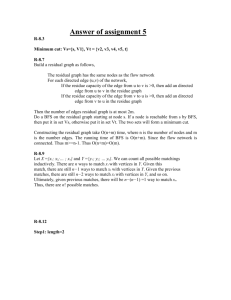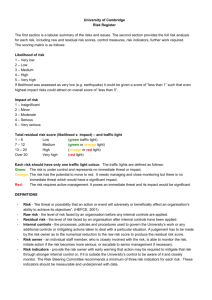Seventh Lecture
advertisement
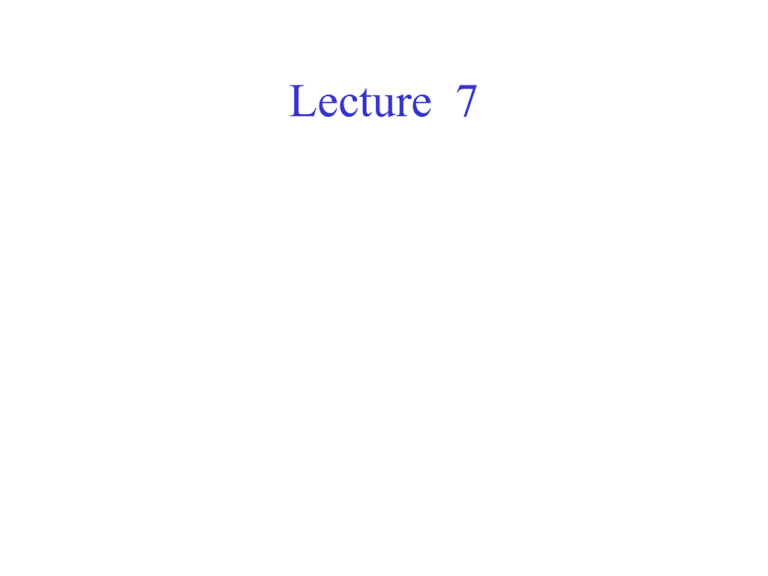
Lecture 7
Network Flows
We consider a network with directed edges.
Every edge has a capacity.
If there is an edge from i to j, there is an edge from j to i
(possibly of 0 capacity)
There is a source s, and destination d
The objective is to find the maximum flow that can be
sent from s to t.
Flow Maximization
Flow in edge (u, v) is xuv
Maximize the total output flow from the source
d such that
Flow in every edge is upper bounded by the edge
capacity 0 xuv Cuv
Input flow = Output Flow at every node other than the
source and the destination (flow conservation)
v: (v, u) Exvu = v: (u, v) Exuv
v: (v, s) Exvs - v: (s, v) Exsv = -d
v: (v, t) Exvt - v: (t, v) Extv = d
Source
1
1.5
0.5
2.5
Destination
Applications of Network Flow
Routing applications - MIRA
Find a maximum matching in an undirected bipartite graph
Matching is a set of edges such that no two edges
in the set share the same vertex.
Bipartite graph is a graph such that the set of
vertices can be partitioned into two sets A, B and
every edge has a vertex in A and another in B.
Network flow algorithms can be used to find a maximum
matching in a bipartite graph.
As long as the link capacities are integers, there exists at
least one maximum flow which allocates integer flows to
the links,
And there are network flow algorithms which attain this
integer flow allocation.
Consider the bipartite graph with unit capacity associated to all
the edges.
All edges are directed from vertices in A and B.
Add a source and a destination node.
The source has unit capacity edge to every vertex in set A
The destination has unit capacity edge from every vertex in set B
Any integral flow is a matching and vice versa (integral flow
gives 0 or 1 flow values to the edges, corresponding
matching is the edges with flow value 1)
s
So max flow gives a max matching
t
Scheduling on Uniform Parallel
Machines
There are a set of J jobs.
M parallel machines
Every job has a start day and a deadline day.
Job j needs pj days to finish if it is served continuously.
A machine can work on only one job at a time.
A job can be served by only one machine at a time
Preemption allowed: Service of a job can be interrupted, and
jobs can switch machines.
Is there a schedule for completing every job within its
deadline?
Network Flow Formulation
Sort the arrival and the deadlines.
Let the arrival day for job 1 be 1, job 2 3, job 3 4,
Deadline for job 1 is 2, job 2 is 5, and job 3 is 7.
The sorted list is 1, 2, 3, 4, 5, 7
Form the non-overlapping intervals between
arrival and deadline epochs.
The intervals are (1, 2), (3, 4), (4, 5), (5, 7).
There is a vertex corresponding to each job, and a
vertex corresponding to each interval.
A job can be processed in an interval iff the interval is
between its arrival and deadline.
There is an edge between a job and an interval vertices iff
the job can be processed in the interval.
Capacity of the edge is the length of the interval.
There is a source with edge to every job. Capacity of
such an edge to job j is pj (the number of machinedays required by the job j)
There is a destination with edge from every interval.
Capacity of such an edge is M.length of the interval
Let the arrival day for job 1 be 1, job 2 3, job 3 4,
Deadline for job 1 is 2, job 2 is 5, and job 3 is 7.
1
(1, 2)
1
s
p1 2
p2 3
p3
1
1
1
2
(3, 4)
3
(4, 5) 3
3
(5, 7)
6
t
There exists a schedule iff max flow is p1 + p2 + p3
Flows and Cuts
• A cut is a partition of the vertex set into two
nonintersecting sets S and T such that the source
belongs to S and the destination belong to T.
• Capacity of a cut is capacity of the edges crossing
the cut
– C[S, T] = (u, v) E, u S, v TCuv
• Minimum cut is a cut with minimum capacity
among all cuts.
• The value of any flow is less than or equal to that
of any cut.
– Entire flow from source to destination must cross the
Hence, max flow min cut capacity.
Need to show that max flow = min. cut
We will use the concept of residual graphs to prove
this result.
Combinatorial Implications of
Max Flow Min Cut Theorem
The maximum number of edge-disjoint paths from the
source to destination equals the minimum number of
edges whose removal from the network disconnects
the source from the destination.
Maximum cardinality of any matching equals the
minimum cardinality of any vertex cover in a bipartite
graph.
Residual Network
Given a flow, the residual capacity of any edge is the
maximum additional flow that can be sent from node i to j
using edges (u, v) and (v, u).
This value is Cuv - xuv
+
xvu
(ruv)
The residual network is the network with the
edges of positive residual capacity.
1 (3, 4) 3
(2, 2)
2
(2, 3)
(5, 5)
2
(0, 1) 4
Original Network
1 1
3
1
2
1
3
2
5
4
Residual Network
An augmenting path is a path in the residual flow
graph from the source to the destination.
Proof of Maxflow
MincutTheorem
Suppose there is no augmenting path from the source to
the destination .
Let S be the set of nodes which can be reached
from the source in the residual network.
Let T be the remainder of the nodes.
Clearly s S and t T and S, T constitute a cut in the
graph.
There is no edge between vertices in S and T in the residual
graph.
Clearly, any edge (u, v) between S and T have 0
residual capacity, ruv =
0
This means that Cuv – xuv + xvu = 0
Note that xuv Cuv and xvu 0
It follows that xuv = Cuv and xvu = 0 for
any edge crossing the cut.
Can see intuitively as well as argue that the net flow between
the source and the destination is the flow from S to T – the flow
between T to S, i.e.,
(u, v) E, u S, v Txuv - (u, v) E, u S, v Txvu
The first term is C[S, T] = (u, v) E, u S, v TCuv
(the capacity of the cut).
The second term is 0.
Hence, the net flow from the source to the
destination is equal to the capacity of the cut.
Since value of any flow is upper bounded
by the capacity of any cut and hence the S,
T cut, this flow is the max flow.
Since the capacity of any cut is lower bounded by
the value of any flow, and hence this flow, the S,
T cut is the minimum cut.
It follows that the max flow = min cut.
All we need to show that there exists a flow for which the
residual network has no augmenting path.
We will present an algorithm which computes such a
flow in finite time.
From the previous argument such a flow is the max.
flow.
Generic Augmenting Path
Algorithm
Note that the capacity of every edge (u, v) in the
residual network is the maximum additional flow
from u to v, using both the edges between u and v.
Consider a path P from s to t in the residual
graph. Clearly the flow from s to t can be
augmented by the minimum capacity in the
augmenting path.
Initially, flow is 0
Construct the residual network
while the residual network has a directed
path from s to t (augmenting path)
Identify an augmenting path P from s to t
Let C be the capacity of the
augmenting path P
Send C units of flow along P
Update the residual network
Route 1 unit along 1-2-3-4
Route 4 units along 1-3-4
source
1
2
2
source
4
1
3
3
5
1
4
3
2
2
4
3
41
1
4
destination
destination
Original Network/Residual Network with 0
flow
source
source
1 4
1 1
2
2
1
Residual Network
1 4
3
1
Route 1 unit
5 along 1-2-4
4
destination
2
2
2
1
3
1
5
4
No
augmenting
path
destination
Complexity Analysis
When the algorithm terminates, the residual
network has no augmenting path.
By the previous argument, the output of this algorithm
is a max flow
We will argue that the algorithm terminates in
O(VEC) complexity, if every link has an integer
capacity, and C is the maximum capacity of the link
An augmenting path can be found in O(V + E)
A residual network can be computed in O(E)
Every time there is an augmentation, flow
increases by 1 unit.
Since every edge capacity is upper bounded by C, and there
are O(V) edges crossing the cut {s}, {V – s}, max flow is
O(VC)
So there are O(VC) augmentations.
Each augmentation has an augmentation complexity +
residual network computation complexity. O(V + E) +
O(E)
Overall complexity is O(VEC)
The proof can be extended to rational capacities.
Verify that the complexity for rational
capacities is O(VEC/c), where c is the least
positive capacity in the network.
However, the algorithm may not terminate
for irrational capacities, and the successive
flow values may converge to a value strictly
less than max-flow.
However, there are other algorithms which converges for
irrational capacities to the maxflow value, and the
maxflow mincut theorem holds irrespectively.
Slow Speed of Convergence
Convergence takes long time for large capacity
values.
source
1
C
2
C
1
First route 1 unit through 1-2-3-4
3
C
Then route 1 unit through 1-3-2-4
Again, 1-2-3-4…
C
4
destination
Repeat the cycle.
Network flow will be generated in O(C) time
Capacity Scaling Algorithm
The above problem goes away if we route traffic
along the maximum capacity augmenting path.
We need just 2 iterations!
It can be shown that routing traffic along the maximum capacity
augmenting path reduces the number of iterations to O(Elog C)
as opposed to O(VC)
However we need O(ElogE) complexity to locate the
maximum capacity augmenting path as opposed to O(E) for
locating any augmenting path.
But, by choosing augmenting paths with ``sufficiently
large’’ capacity, though not the largest capacity the
algorithm runs in overall O(E2log C) time.
G(, x) is a subgraph of the residual network for flow x,
Such that only edges with residual capacity not less than
are included.
1. Start with 0 flow (x = 0) and = 2log C
2. Compute a residual capacity graph G(, x)
3. If the source is connected to the destination,
•
choose any augmenting path and identify its capacity.
•
Augment the existing flow with the capacity of this
path.
•
Back to Step 2.
4. Else,
•
Set = /2
•
If ( 1) go to step 2, else stop.
Complexity Analysis
Consider the number of augmentations done
with a particular value of .
First note that one is trying the value , because
with the current flow value, there is no path from
the source to the destination with capacity 2
Let S be the set of nodes reachable from source in G(2,
x), where x is the flow when we start with . Clearly, the
edges crossing the cut (S, V-S) have capacity less than or
equal to 2.
The capacity of the cut is at most 2E .
This means that the max flow in the residual
network is upper-bounded by 2E .
Note that the difference in max flow and current flow is
upper bounded by the max flow in the residual network.
This means that current flow can not be increased by
more than 2E .
Any augmentation in the -phase is increases
the flow by at least .
So we can perform only 2E such augmentations.
For each value of , there are 2E augmentations.
Each augmentation has complexity O(E) as
before.
We try log C values of .
So overall complexity is O(E2 log C)
However, the complexities of both the previous algorithms
depend on the maximum capacity value, and are hence
called pseudo-polynomial.
Polynomial Complexity
Algorithms
• Complexity is a polynomial in the number of
edges and vertices
• Shortest Augmenting Path algorithm
• Generic preflow-push algorithms
– FIFO pre-flow push algorithms
– Highest capacity pre-flow push algorithms
Shortest Augmenting Path
Algorithm
Shortest Augmenting Path Algorithm forwards the flow
along the shortest path from the source to the destination in
the residual network.
Note that if we repeatedly use the shortest path to forward the
flow, the length of the shortest path increases
It can be shown that during E augmentations, the length of
the shortest path is guaranteed to increase.
The length of the shortest path can not increase beyond V.
Hence, there are at most VE augmentations.
Distance Labels
There is a function d from the node space to the set of
nonnegative integers.
d(i) is a nonnegative integer for every node I
d(t) = 0
d(i) d(j) + 1, for every edge (i, j) in the residual
network
An edge (u, v) in the residual network is an
admissible edge if d(u) = d(v) + 1
An admissible path is one which consists of only
admissible edges
Properties of Distance Labels
Distance label of a node is less than or equal to
the length of the shortest path from the node to
destination ( here the weight of a path is the
number of hops in the path).
Observe that an admissible path from the source
to the destination is indeed the shortest path.
Hence, if the distance label of the shortest
path is V, then there is no augmenting path in
the residual network.
As we have proved earlier, the flow is the
maximum flow.
Algorithm Description
Start with distance labels equal to the shortest
path lengths to the destination in the original
network.
Always route flow along an admissible path in
the residual network.
Additional flow routed each time equals the capacity of
the chosen admissible path.
While constructing an admissible path, change
the distance functions as necessary.
Note that the residual network changes as flows are
updated.
However, the efficiency of the algorithm is that
all distance labels need not be changed every
time the residual network is updated because of
flow augmentation.
Admissible paths are constructed as follows:
Source node selects an admissible outgoing edge.
End node of this edge selects an admissible
outgoing edge.
Suppose no outgoing edge is admissible for an edge.
Consider a node u. It may well happen that d(u) < d(v) + 1
for all of its outgoing edges (u, v).
In that case, the label of u is increased to
minv: (u, v) residual network{d(v) + 1}.
Now the edge (w, u) in the path constructed so far may
no longer be admissible as d(u) increases.
In that case, (w, u) is removed from the path, and the
process searches for another admissible edge from w. If
none are found, then the label of w is increased further,
and so on.
Once an admissible path is computed (path under
construction reaches the destination), existing flow is
augmented by the capacity of the path.
Residual network is modified.
One looks for a new admissible path.
The algorithm terminates only when the
distance label of the source reaches V.
Example
3
s
2
3
s
2
1
2
1
1
1
1
1
1
2
1
2
1
0
t
1
0
t
(s, 1) is admissible
But there is no admissible edge from node 1.
So node 1 is re-labeled to 4
Consequently, s is relabeled to 5. Algorithm
terminates
Proof for Correctness
Supposing the distance labels satisfy the required distance
properties at termination, then termination occurs only when
there is no augmenting path from the source to the
destination. Why?
This means at termination the output is the
max flow as argued earlier.
We need to argue that the distance properties hold at
termination.
In fact, we will argue that re-labeling does not violate
the distance properties.
Relabeling increases the distance function for a node.
Possible violation takes place if after relabeling node
i, d(i) d(j) + 1, for some edge (i, j) in the residual
network.
But we know that after relabelling
d(i) =mini: (i, j) residual network{d(j) + 1}.
Also, when we route additional flow residual network
changes.
But this change is restricted to the augmenting path only.
Some edges disappear along this path.
This does not cause any violation
However, some edges appear as well!
But if an edge (j, i) appears, then flow has been
routed along (i, j) . This means (i, j) is admissible.
This means d(i) = d(j) + 1
It follows that d(j) d(i) + 1
Hence, distance labels are always valid!
Complexity Analysis
A combinatorial argument shows that the
complexity is O(V2E)
